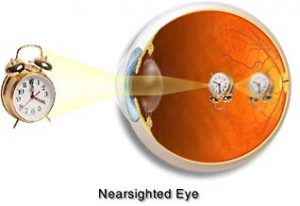Eye Care > Common Eye Conditions > Myopia
Nearsightedness or myopia, occurs when light entering the eye focuses in front of the retina instead of directly on it. This is caused by a cornea that is steeper, or an eye that is longer, than a normal eye. Nearsighted people typically see well up close, but have difficulty seeing far away.
This problem is often discovered in school-age children who report having trouble seeing the chalkboard. Nearsightedness usually becomes progressively worse through adolescence and stabilizes in early adulthood.

Nearsightedness is detected with a vision test and refraction.
The treatment for nearsightedness depends on several factors such as the patient’s age, activities, and occupation. Vision can be corrected with glasses, contact lenses or surgery. Refractive procedures such as LASIK can be considered for adults when the prescription has remained stable for at least one year.
Illustrations by Mark Erickson
With acknowledgement to St. Lukes Eye Hospital.
| Cookie | Duration | Description |
|---|---|---|
| cookielawinfo-checkbox-analytics | 11 months | This cookie is set by GDPR Cookie Consent plugin. The cookie is used to store the user consent for the cookies in the category "Analytics". |
| cookielawinfo-checkbox-functional | 11 months | The cookie is set by GDPR cookie consent to record the user consent for the cookies in the category "Functional". |
| cookielawinfo-checkbox-necessary | 11 months | This cookie is set by GDPR Cookie Consent plugin. The cookies is used to store the user consent for the cookies in the category "Necessary". |
| cookielawinfo-checkbox-others | 11 months | This cookie is set by GDPR Cookie Consent plugin. The cookie is used to store the user consent for the cookies in the category "Other. |
| cookielawinfo-checkbox-performance | 11 months | This cookie is set by GDPR Cookie Consent plugin. The cookie is used to store the user consent for the cookies in the category "Performance". |
| viewed_cookie_policy | 11 months | The cookie is set by the GDPR Cookie Consent plugin and is used to store whether or not user has consented to the use of cookies. It does not store any personal data. |